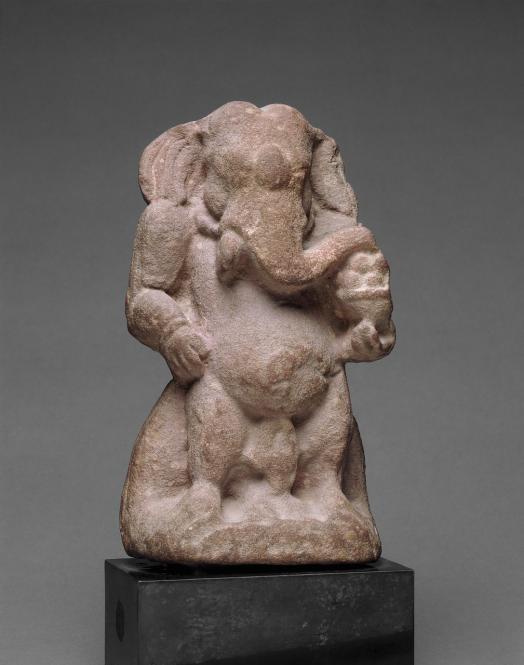
Object Title
Two–Armed God Ganesha Holding a Bowl of Sweets
Measurements
19.3 x 11.2 x 5.6 cm (7 9/16 x 4 3/8 x 2 3/16 in.)
Creation Date
c. 3rd/4th Century CE
Credit Line
James W. and Marilynn Alsdorf Collection. Gift of Marilynn Alsdorf
Museum Name
Museum Contact
publicaffairs@artic.edu
Culture
Country of Origin
Object Type
Materials / Techniques
Object URL
https://www.artic.edu/artworks/153513/two-armed-god-ganesha-holding-a-bowl-of-sweets
Museum's Definition of Antiquity
Created before late 6th Century CE
Provenance Information
With James Singer, Oriental Art, London, by Feb. 21, 1979 [this and the following according to receipts from James Singer, Feb. 21 and Mar. 1, 1979; copies in curatorial object file]; sold to James W. Alsdorf (1913–1990) and Marilynn B. Alsdorf (1925–2019), Winnetka and Chicago, IL, Feb. 21, 1979; by descent to Marilynn B. Alsdorf, Chicago, 1990 [on long-term loan at the Art Institute, Sept. 17, 1997; publicly promised as a gift to the Art Institute of Chicago, 1997; signed a promised gift agreement for the work, 2002]; given to the Art Institute of Chicago, 2021.
Exhibition Information
Philadelphia Museum of Art, Manifestations of Shiva, Mar. 29–June 7, 1981, cat. 61; Fort Worth, TX, Kimbell Art Museum, Aug. 1–Sept. 27, 1981; Seattle Art Museum, Nov. 25, 1981–Jan. 31, 1982; Los Angeles County Museum of Art, Mar. 23–May 5, 1982.
Art Institute of Chicago, A Collecting Odyssey: Indian, Himalayan, and Southeast Asian Art from the James and Marilynn Alsdorf Collection, Aug. 2–Oct. 26, 1997, cat. 54.
Art Institute of Chicago, A Collecting Odyssey: Indian, Himalayan, and Southeast Asian Art from the James and Marilynn Alsdorf Collection, Aug. 2–Oct. 26, 1997, cat. 54.
Publication Information
Stella Kramrisch, Manifestations of Shiva (Philadelphia: Philadelphia Museum of Art, 1981), 74–75, cat. 61.
Sara L. Schastok, The Samalaji Sculptures and 6th century Art in Western India (Leiden: E.J. Brill, 1985), 59, fn. 10.
Pratapaditya Pal with contributions by Stephen Little, A Collecting Odyssey: Indian, Himalayan, and Southeast Asian Art from the James and Marilynn Alsdorf Collection (Chicago: The Art Institute of Chicago in association with Thames and Hudson, 1997), 51 (ill.), 284–85, cat. 54.
Sara L. Schastok, The Samalaji Sculptures and 6th century Art in Western India (Leiden: E.J. Brill, 1985), 59, fn. 10.
Pratapaditya Pal with contributions by Stephen Little, A Collecting Odyssey: Indian, Himalayan, and Southeast Asian Art from the James and Marilynn Alsdorf Collection (Chicago: The Art Institute of Chicago in association with Thames and Hudson, 1997), 51 (ill.), 284–85, cat. 54.
Section of the AAMD Guidelines relied upon for the exception to 1970
Cumulative facts and circumstances
Explain why the object fits the exception set forth above
This acquisition falls within two exceptions: cumulative facts and circumstances as well as gift or bequest expected or on loan prior to 2008. First, the cumulative facts and circumstances known to the Art Institute of Chicago at the time of the acquisition allowed it to make an informed judgment to acquire the object. The object was purchased by James Alsdorf and Marilynn Alsdorf, Winnetka and Chicago, Illinois, in 1979 from James Singer, Oriental Art, London, according to the receipts, copies of which are in the curatorial files. Attempts to determine from whom the gallery acquired the object were unsuccessful. The object was first exhibited at the Philadelphia Museum of Art in 1981, and traveled to the Kimbell Art Museum, the Seattle Art Museum, and the Los Angeles County Museum of Art. It also appeared in an exhibition at the Art Institute of Chicago in 1997. The object was publicly displayed in the Indian, Himalayan, and Southeast Asian Art Galleries in McKinlock Court between 2003 and 2004, and in the Alsdorf Galleries of Indian, Southeast Asian, Himalayan and Islamic Art between 2008 to 2017, and again since 2018. The object has been published in three major catalogs on South Asian Art: Manifestations of Shiva (1981); The Samalaji Sculptures and 6th century Art in Western India (1985); and in A Collecting Odyssey: Indian, Himalayan, and Southeast Asian Art from the James and Marilynn Alsdorf Collection (1997). In addition, the object will be the earliest example in the Art Institute’s collection of a representation of the god Ganesha from the Kushan-Gupta transitional period in Mathura, India, from the 3rd/4th century CE. Second, the acquisition of the object was by gift and the object was on loan to the Art Institute prior to 2008. The Alsdorfs lent the object to the Art Institute of Chicago on Sept. 17, 1997; Marilynn Alsdorf publicly promised the object as a gift to the museum in 1997; and the object joined a larger group of promised gifts in an agreement signed in 2002.